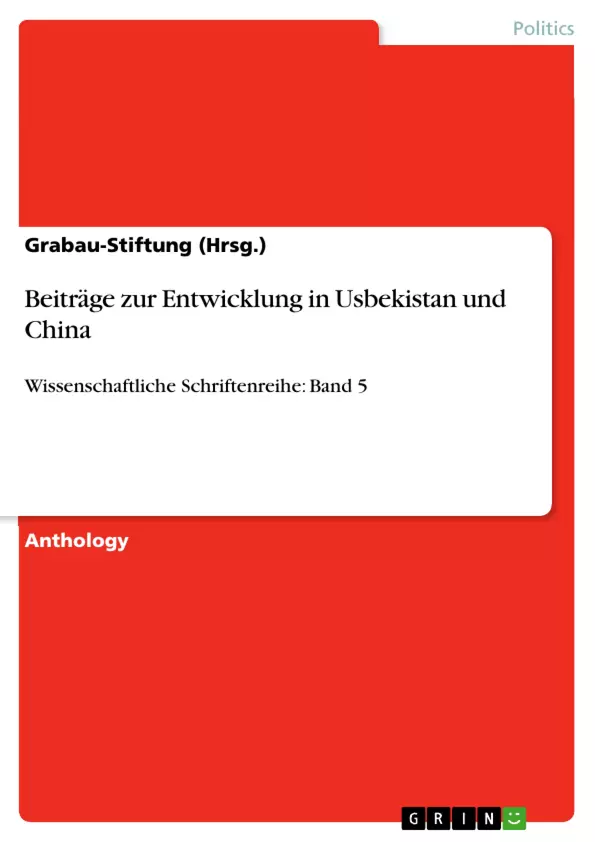Preface
We are very proud to present on today the following compendium with articles of several junior scientists from Uzbekistan, China and Germany about different economic topics.
Mr. Nuriddin Mamajonov from the embassy in Berlin gives a short introduction about Uzbekistan.
The articles in the first part are from several scientists from universities in Tashkent and Namangan. The themes varied from the traditional economic and new economic questions to tourism and translation problems.
All articles from the authors of China and Germany would be held during the “First international workshop in September 2011 at Qingdao Technological University, School of Management.” Prof. Zhao Jinxian from School of Management and me are sure, that this workshop will intimate the connections between the institutions Qingdao Technological University and Hochschule Magdeburg-Stendal and also the relationships between China and Germany. Many thanks to all helpful hands, who have contribute in organizing this mutual project. We intend to held a second workshop in 2012/2013 and we will try to continue the scientific exchange between our both institutions also in some more directions.
March 2012
Prof. Dr. Fritz-René Grabau
Inhaltsverzeichnis (Table of Contents)
- Preface Vorwort
- Usbekistan
- Ein kurzer Überblick über Usbekistan
- Features of development of ferrous metallurgy of Uzbekistan in the post crisis period
- Establishment and development of the textile cluster in the Republic of Uzbekistan
- Concept of the use of the system of internal control of enterprise
- Social-economic development of Bukhara and its effect on the income of rural population
- Soundness of financial system of Uzbekistan in world crisis conditions
- Reforming of accounting, the problems and ways of its improvement
- Use of corporate information systems in tax service
- Intensifying role of Uzbekistan in the World Trade Organization and economic relationships
- The concept of coordination of employment of rural population
- Issues of creation of the modern logistic infrastructure in Uzbekistan
- Classification of economic factors operating on the operating on the organization and management of innovative processes in corporate structures
- The concept of reformation of the national system of social security in the Republic of Uzbekistan
- Globalization and university education in Uzbekistan
- Development perspectives of tourism market in Uzbekistan
- Problems of management of a professional training for the tourism industry
- Opportunities for the development of eco-tourism in preserved Natural Areas of Uzbekistan
- Higher education in Uzbekistan: reformation, internationalization, and quality
- The role of innovation systems in the education system of the Republic of Uzbekistan
- Features of formation and marketing development of professional training in sphere of educational services
- Educational transformation of intellectual capital escalation area of Uzbekistan
- Uzbek language during the 1920s: overview the materials of "Education and teaching" periodical publication
- About some translational problems of poetic figure "Kutadgu Bilig" (Wisdom of Royal Glory)
- Identifikationsprobleme und die Vorbereitung eines "Terminologischen Wörterbuchs" der Translationswissenschaft
- China
- Introduction for the Chinese Part
- Doing business in Germany. An overview for Chinese founders and entrepreneurs
- Based on OPM3 and P-CMM of the Construction Project Management Team Effectiveness Promotion System
- The basic contradictions of capitalist society in the condition of Subprime Crisis
- Research on Prediction of Metro Traffic Benefit
- Applying DEA to the Construction Safety Management Performance Evaluation on Intensive Land Use in Urban District - Taking Qianwan Bonded Zone as Example
- Study on an Information Process System for Appraising Key Construction Projects' Risk
- Die Minderheitenpolitik Chinas am Beispiel der Uiguren
- After-sales strategies for Chinese car manufactures in the European market
- The key defining factors of the national Competition according to Porter with regard to the telecommunications market on the example Germany vs. China
- The meaning of stamps, China vs. Germany
Zielsetzung und Themenschwerpunkte (Objectives and Key Themes)
This compendium presents a collection of articles from junior scientists from Uzbekistan, China, and Germany, exploring diverse economic topics. The objective is to foster dialogue on key issues and facilitate scientific exchange between participating institutions.- Economic Development and Challenges in Uzbekistan
- The Role of Innovation and Technology in Economic Growth
- International Business and Trade Dynamics
- Higher Education, Training, and Skill Development
- Cultural and Social Dynamics in a Globalized World
Zusammenfassung der Kapitel (Chapter Summaries)
The first section of the compendium focuses on Uzbekistan, exploring a range of economic and social topics. Articles cover diverse themes such as the development of ferrous metallurgy, the textile industry, and the role of internal control in enterprises. Other chapters address social-economic development, financial system soundness, accounting reforms, and the impact of globalization on university education. The second part of the compendium, dedicated to China, delves into various topics related to business, management, and international relations. Articles explore themes such as doing business in Germany, project management team effectiveness, the impact of the Subprime Crisis on capitalist society, and metro traffic benefit prediction. Other contributions examine construction safety management, risk assessment in construction projects, China's minority policies, after-sales strategies for Chinese car manufactures in Europe, and a comparative analysis of competition in the telecommunications market between Germany and China.
Schlüsselwörter (Keywords)
This compendium focuses on economic and social topics, exploring themes such as economic development, innovation, international trade, higher education, globalization, and cultural dynamics. Specific topics covered include ferrous metallurgy, the textile industry, internal control, financial systems, accounting reforms, university education, project management, subprime crisis, construction management, risk assessment, minority policies, international business, and comparative analysis of competition in the telecommunications market.- Citar trabajo
- Grabau-Stiftung (Hrsg.) (Autor), 2012, Beiträge zur Entwicklung in Usbekistan und China, Múnich, GRIN Verlag, https://www.grin.com/document/190994



